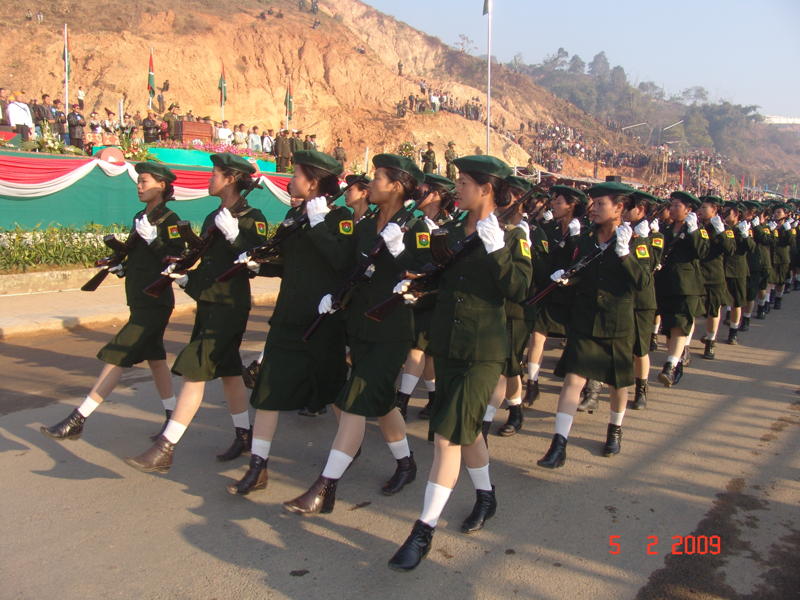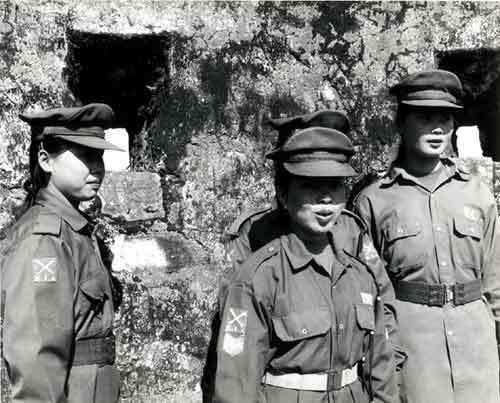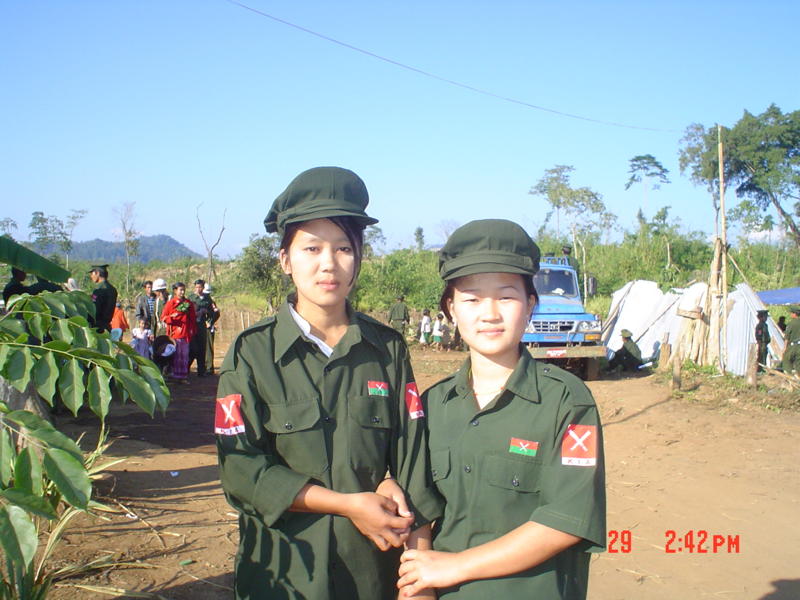Medical Sergeant Maran Ja Hkam, her braided hair reaching down to her ankles and white lab-coat covering her military uniform, administered an injection to a tuberculosis patient in an army hospital in Laiza, the headquarters of the Kachin Independence Organization ...
Medical Sergeant Maran Ja Hkam, her braided hair reaching down to her ankles and white lab-coat covering her military uniform, administered an injection to a tuberculosis patient in an army hospital in Laiza, the headquarters of the Kachin Independence Organization (KIO). The twenty-eight year old Kachin woman has worked for the Kachin Independence Army, the military branch of the KIO, since 2003.
 The KIA/KIO and the Burmese Army signed a ceasefire agreement nine years before she began, so she has never had to worry about being sent to the front lines for combat duty like many older Kachin women soldiers before her.
The KIA/KIO and the Burmese Army signed a ceasefire agreement nine years before she began, so she has never had to worry about being sent to the front lines for combat duty like many older Kachin women soldiers before her.
At the beginning of the Kachin revolution in 1961, all KIA soldiers were constantly on alert and ready to go to the front.
Sixty-three year-old, Hkawn Tawng, was a fifteen year-old schoolgirl, in Mayang Village, Kachin State, when she joined the KIA with five of her friends, two years into the revolution.
She and many other Kachin young people were eager to fight against their enemy, the Burmese Army. They soon got what they wanted.
“The word was spreading that there was a Kachin armed group training and fighting in the jungle. That army was fighting for all Kachin people,” she told BNI in a recent interview.
At first, KIA officials told her she was too young to fight, and she should go home and continue her education.
However, she was determined to become a KIA combat soldier.
“I had a Sten Gun, because it was lighter and shorter and was better for us girl soldiers. We were very proud when we carried it. The Sten Gun was very nice,” she said with a smile.
One day, she and a friend were ordered to carry a letter from Ginyaw Village to Gaidaw, in northern Shan State. During their trip, they were very afraid and could not even speak as they were traveling, trying to silently slip past Burmese troops.
When they arrived at Loi Phyap (PhyapMountain), the enemy discovered them and opened fire.
Hkawn Tawng was terrified when her friend was shot. She fled into the jungle.
She worried her friend was dead, as she was running for her life.
 She could not sleep that night because she was wondering if her friend was dead, or had she just been wounded?
She could not sleep that night because she was wondering if her friend was dead, or had she just been wounded?
She searched for her early the next morning.
“I was very upset about her. I wasn’t sure how I would care for her if she was still alive,” she remembered.
Eventually, she found her fellow soldier bleeding from a chest wound, near a creek.
She told her, “Don’t give up. You won’t die.”
She went back to Ginyaw Village and to inform her superiors about the ambush and get help for the wounded soldier, who recovered quickly after medical treatment.
In 1963, there were 50 women soldiers in the KIA. Some, like Lieutenant Ru Hta and Lt. Htoi Mai, became famous. The KIA started the first Women Army Corp training with 10 women soldiers in 1968.
However, Hkawn Tawng remembered how she worked as a combat nurse for 8 years on the front line without promotion. Even though women soldiers served in the same role as males, the women were often not promoted.
Hpawn Roi Hkawn Ja, who attended the first Women Army Corp training, had the same experience. She worked as a medic at the front line for many years but she didn’t get any rank promotion.
Now she lives in Lai Za town and works for the Kachin Women Organization.
“Most women retired from the army after they get married. We pushed for promotion, but didn’t receive it,” she said.
Salang Ka Ba Doi Pyi Sar, Deputy in Charge of Civilian Administration for the KIO, said in an interview the fact that women soldiers wanted to stay home after they married was the reason for the army’s reluctance to promote them.
“At medical school, they promised to serve for many years but actually they only served until they married. Women soldiers who served their time did get promoted,” he said.
Things changed for women soldiers, however, after the KIA negotiated the ceasefire with the military junta.
Women soldiers like Laphai Htu Bu and Chan Lawm got promoted to the highest rank of Major when they retired. As well, Tawng Nu, was promoted to Captain.
 According to Salang Ka Ba Doi Pyi Sar, there are 50,000 soldiers in five brigades in the KIA currently. About 4,000 are women. Among them, there are 800 women soldiers who carry weapons.
According to Salang Ka Ba Doi Pyi Sar, there are 50,000 soldiers in five brigades in the KIA currently. About 4,000 are women. Among them, there are 800 women soldiers who carry weapons.
Today, many women are working as school teachers, staff and entertainers for front line soldiers.
“I feel so sorry for the older women soldiers because they were not promoted, even though they fought against the Burmese Army,” a young women soldier said in an interview.
“Now we are lucky. We haven’t needed to go to the front. I think we are very lucky, compared to the older women in the KIA. We are very afraid if we go to the front line for one month (to entertain the troops). I sympathize with them and respect them.”
Grandma Hkwan Tawng is busy today with prayer meetings and church work for the KIO, in Lai Za, the headquarters.
She regrets that she had to leave her parents to join the army as a teen and had to leave school. She never saw her parents again.
However, her desire to serve her people outweighed the personal sacrifices she had to make, including being passed over for promotion.
“It wasn’t fair because we medics went to the front line, tried our best, and worked hard but we didn’t get any promotion. However, I didn’t worry about it at the time. I only wanted to work for our people. I would probably be more concerned about it today. If I was not promoted I may feel upset. Today’s women soldiers want to be promoted,” she said.


